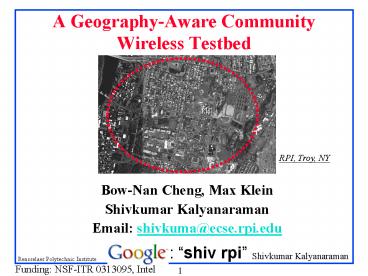A GeographyAware Community Wireless Testbed - PowerPoint PPT Presentation
1 / 21
Title:
A GeographyAware Community Wireless Testbed
Description:
Wireless Ad-hoc Mesh Networks: Challenges. Physical Layer: ... Lots of work in ad-hoc networks coming to fruition. Startup companies in the mesh networks space: ... – PowerPoint PPT presentation
Number of Views:50
Avg rating:3.0/5.0
Title: A GeographyAware Community Wireless Testbed
1
A Geography-Aware Community Wireless Testbed
RPI, Troy, NY
- Bow-Nan Cheng, Max Klein
- Shivkumar Kalyanaraman
- Email shivkuma_at_ecse.rpi.edu
shiv rpi
Funding NSF-ITR 0313095, Intel
2
Outline
- Wireless Ad-hoc Mesh Networks Challenges
- Physical Layer A street-level network
- Network Layer Addressing Framework and
Auto-configuration - Microcosm Test Bed Lab
- Future Work
3
Community Wireless Whats New?
- Lots of work in ad-hoc networks coming to
fruition - Startup companies in the mesh networks space
- Tropic networks, Mesh networks etc
- Whats different in CWNs? Why a testbed?
- Unmanaged, but operational network
- Ad-hoc, but operational
- Fixed (I.e. not mobile)
- Medium scale
- Supports organic growth and evolution
- Supports legacy internet traffic
4
Community Wireless Networks Challenges ? Why a
Testbed?
- Auto-configuration and auto-management
- Only lightweight governance allowed
- Beyond addressing routing, naming, other
protocols - Higher quality than ad-hoc networks to support
legacy applications (links, end-to-end transport) - Capacity maximization (c.f. Gupta/Kumar results)
gt routing choices, traffic engineering - Cheap, simple, standards-based components.
- New community apps (eg p2p video, games).
- Several nitty-gritty issues leading to new
protocol design challenges best researched in a
testbed
5
Broadband exists. Why CWN?
- Ans Multiplicity.
- Cable modem and DSL and CWN and
- Commodity gt cheap to get multiple access
facilities
USB/802.11a/b
Phone modem
802.11a
Firewire/802.11a/b
WiFi (802.11b)
Ethernet
6
Physical Layer Street-level vs Rooftop
- Leverage directionality and quasi-LOS
- of streets gt better quality links
- Omni-directional vs.
- Directional Antennas
Eg
7
Antennas Pringles cans disappoint
- Cheap
- But low gain
- 6.01425 dBi
8
COTS Directional Antennas
2.4 GHz 12 dBi Radome Enclosed Yagi Superior
performance Light weight All weather operation
45 beam-width Can be installed for either
vertical or horizontal Polarization. Includes
tilt and swivel mast mount
9
Network Layer Addressing
- Goals
- IP-based architecture
- Support for geographic routing
- Why? Medium-scale, Organic Growth,
Location-services - Support for local traffic engineering
- Why? Dirn antennas, capacity maximization.
- Support for distributed auto-configuration
- Proposed Addressing Framework
- Geographic Distributed Addressing (GDA)
10
Geographic Distributed Addressing (GDA)
Idea Hash GPS -gt IP address
11
(No Transcript)
12
Why GPS-to-IP?
- GPS-to-IP gt
- Medium-scale, Server-less auto-configuration,
- With routable addresses
- IP address has dual semantics geographic and
topological - Long-range geographic routing/TE
- Short-range (k-hop) topological RF-aware QoS
routing - using the same IP/geographic address
- Location information also leveraged to
auto-configure other L2/L3 protocols - Eg cluster/area boundaries for routing, support
location-based CWN services
13
Future Geographic Source Routing
Gives us ability to pick randomly from a large
number of physical routes
Source Routing i.e. flex, large header
Greedy Routing i.e. no header or state, but no
flex
Trajectory-Based Routing
14
Deployment Plan
- Microcosm lab internal prototyping, tests
- Logistics for long-term deployment around RPI
campus (eg dealing with landlords etc) - RPI-CIO providing access points at borders of
campus to help connect the CWN to RPIs internal
network
15
Microcosm Test Lab
Variable attenuators, and directional antennas
allow flexibility in testing
We also intend to use public facilities like
Utahs Emulab Wireless
16
Testbed Hardware contd
17
Testbed Software
- Fixed Nodes
- RedHat Linux Kernel 2.4.20-30.9
- Click Modular Router CVS March 5
- Autoconfigured Nodes
- Redhat Linux 9 2.4.20/21 Kernel
- Click Modular Router CVS March 5
- HostAP 0.2 Driver Utilities for
- Firmware flashing
- GPSD 1.10
- DHCP Server preconfigured NAT
- w/ iptables ipmasq
- Customized GSP Autoconf Scripts
- Webserver SSH in the future
- Intel Stargate/east platform will be considered
as well
18
Future Work
- GeoNet Framework to verify intersection between
Geography and Topological routing - K-hop RF Awareness, QoS routing
- Distributed Geographic Traffic Engineering
- Test Bed Improvements
- GPS Simulation
- Lab Reflectivity
- Transport and application-layer activities kicked
off - Key survival quality under heavy erasure
conditions. - Collaboration ongoing with Intel and ATT
Research
19
Vision 1 Multipath P2P Video/Data Over CWNs
Traffic engineering Transport level upgrades
20
Vision 2 free-space-optical CWN
Ongoing NSF-STI project
21
Thanks!
Student Heroes Bow-Nan Cheng
chengb_at_rpi.edu Max Klein maxklein_at_stanford.edu
shiv rpi































